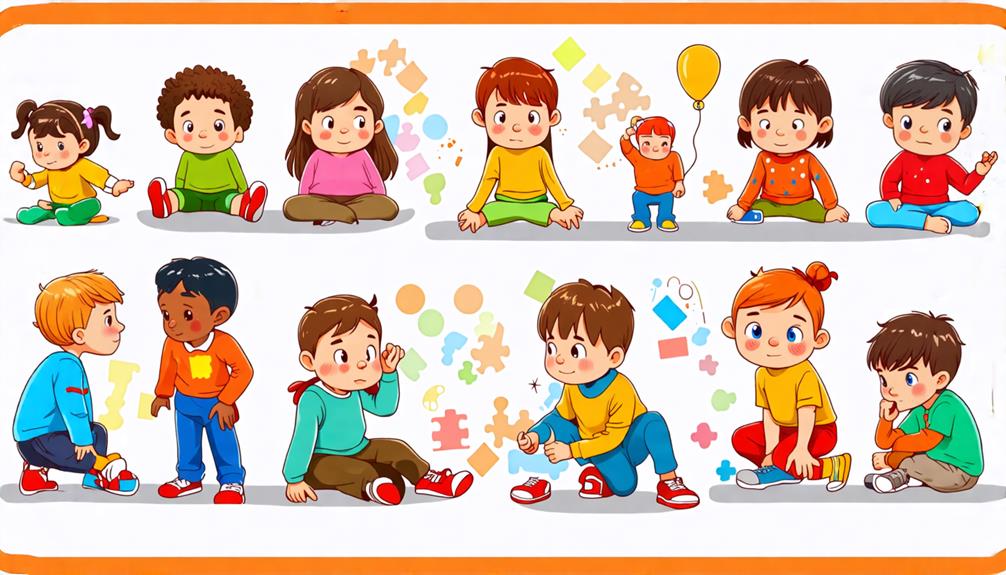Early detection of autism in children can be critical. Recognizing key autism traits early on helps start the right intervention strategies. These traits, like avoiding eye contact or having speech delays, are the first clues in understanding Autism Spectrum Disorder (ASD). Noticing these signs early can make a big difference in a child’s development.
Autism traits vary widely, so exploring this topic fully is crucial. Each child with ASD is unique, showing different signs and symptoms. Understanding the broad range of essential autism traits helps caregivers and professionals provide the best support. This discussion highlights the importance of recognizing these early signs and their impact on a child’s life.
Key Takeaways
- Early signs of autism include reduced eye contact, limited facial expressions, and lack of response to name, often noticeable between 12 and 18 months of age.
- Autism may manifest in limited interests, repetitive actions, unusual movements, and distinct responses to sensory stimuli like sounds and lights.
- Language delays, such as echoing and repeating words, adult-like speech, and struggles with requests, are significant indicators of autism in children.
- There can be variations in autism symptoms between boys and girls, highlighting the need for gender-inclusive evaluations for appropriate interventions.
Understanding Autism Spectrum Disorder
Autism Spectrum Disorder (ASD) is a complex developmental condition that presents a broad array of traits and intensity levels, often becoming noticeable between 12 and 18 months of age. It is characterized by a spectrum of symptoms varying in severity and manifestation.
Key among these are difficulties with social communication, which can profoundly impact a child’s ability to interact with peers and navigate their surroundings.
Understanding the nature and nuances of ASD is crucial, particularly for individuals seeking to serve and support affected children. A child with ASD may experience speech delays and sensory sensitivities or exhibit uncommon movements, each of which requires a specific approach for effective management.
Early intervention is critical for children with ASD. The sooner the disorder is identified and addressed, the better the outcomes for the child. Early intervention programs can help children develop essential skills, reduce ASD symptoms, and maximize their potential.
Hence, the responsibility lies on caregivers, educators, and healthcare professionals to recognize the signs of ASD and seek early evaluation for intervention. This underscores the significance of fostering a thorough understanding of Autism Spectrum Disorder to serve these children best.
Early Indicators of Autism
Early detection of autism in children is essential for implementing timely interventions and ensuring the best outcomes. By understanding the early indicators of autism, such as reduced eye contact, limited facial expressions, or lack of response to their name, parents and caregivers can seek professional help as soon as possible.
This discussion aims to provide insights into these early signs, the importance of early diagnosis, and available resources to aid parents and caregivers in their journey.
Understanding Autism Spectrum Disorder
Recognizing the early signs of Autism Spectrum Disorder, which can include reduced eye contact or an inability to respond to their name, plays a significant role in identifying and addressing this condition in children. These initial indicators can manifest as early as infancy, with decreased sensitive responses or heightened aggression as potential red flags.
Autism is a complex, multifaceted disorder, and symptoms usually appear by age 2. Each child with autism presents a distinct pattern of behavior and levels of severity, making it essential to understand the broad spectrum of this condition.
One of the most common challenges children with autism face is communication. They may struggle understanding simple questions or directions and often find social interaction puzzling. The nuances of conversation, such as the exchange of back-and-forth communication, may be challenging for them to grasp.
Additionally, these children may exhibit particular behavioral patterns, such as fixating on specific routines or object details. They might also be sensitive to light, sound, or touch stimuli. Understanding these early signs of autism is vital in providing the necessary support and intervention for these children.
Importance of Early Diagnosis
Given the complexity of Autism Spectrum Disorder, understanding its early indicators, such as speech delays or social communication difficulties, is instrumental in enabling timely diagnosis. Such early indicators, along with uncommon movements or sensory sensitivities, can often be observed when a child reaches 12-18 months of age. The diagnosis of autism can be reliably made by age 2, allowing for the commencement of necessary interventions.
Recognizing these early signs is conducive to a timely diagnosis and aids in understanding the child’s distinct needs. This understanding facilitates a tailored approach to nurturing and educating the child, fostering improved development and overall well-being outcomes.
Consulting with a pediatrician or school district for an assessment is a proactive measure that can lead to early intervention. This, in turn, can have a profoundly positive impact on the child’s future. It underscores the critical importance of early diagnosis in autism, emphasizing the direct link between early detection and the potential for enhanced quality of life.
Resources for Parents and Caregivers
Often, parents and caregivers feel overwhelmed when they first suspect their child might be showing early indicators of autism, which is why diverse resources have been developed to guide and support them through this process. Knowledge is power, and understanding early signs can pave the way for early intervention, greatly enhancing children’s communication and social children.
One of these resources is the First Concern to Action Tool Kit, designed to help parents recognize and respond to early signs of autism in their children. The 100-Day Tool Kit for Young Children is another resource that provides support and guidance to parents in the first 100 days after an autism diagnosis.
Local providers and services also play a pivotal role, offering parents guidance and support to understand and address early signs of autism. The Autism Response Team (ART) is available to provide information and resources to parents and caregivers.
| Resource | Description | Benefit |
|---|---|---|
| First Concern to Action Tool Kit | Guides parents in recognizing early signs | Promotes timely intervention |
| 100-Day Tool Kit for Young Children | Supports parents post-diagnosis | Guides in early stages |
| Local Providers and Services | Offer understanding and support | Tailored assistance |
| Autism Response Team | Provides information and resources | Immediate support |
Autism and Social Communication

A significant number of children diagnosed with autism grapple with challenges in social communication, which can manifest in various ways, including, but not limited to, lack of response when called by name, limited facial expressions, and difficulty in initiating or sustaining conversations. These difficulties in social and communication skills are often coupled with decreased emotional responses or even aggression, further complicating their social interactions.
Even simple tasks, such as understanding questions or following directions, can overwhelm these children, making socializing immensely challenging. They may also have poor eye contact, a common sign of social communication difficulties in autism. These barriers often lead to inappropriate social approaches that can be misinterpreted by those unfamiliar with the disorder.
Understanding the distinct behavior patterns in autistic children is essential in recognizing the disorder. It’s important to remember that each child is distinctive, and their experiences with autism can vary greatly. With patience, empathy, and a deeper understanding of their challenges, we can better support these children in navigating social communication.
Restricted and Repetitive Behaviors
In many instances, children with autism display a range of restricted and repetitive behaviors, which serve as one of the distinguishing characteristics of this condition. Indeed, understanding and recognizing these behaviors can play a crucial role in early detection and intervention.
- Repetitive actions: Children with autism often prefer specific repetitive actions, such as flapping, rocking, spinning, or repeating particular actions. These behaviors usually offer comfort and predictability to the child.
- Limited interests: Another critical feature of autism is limited interests. Children may demonstrate an intense, almost obsessive focus on specific topics or activities to the exclusion of others.
- Distinct response to sensory stimuli: Though this topic will be explored more thoroughly in the subsequent section, it’s important to note that distinct sensory responses often accompany repetitive actions and limited interests.
When equipped with the knowledge of these distinguishing characteristics, professionals and caregivers can contribute significantly towards enhancing the quality of life of children with autism.
Autism: Sensory Sensitivity
Sensory sensitivity, a common characteristic in children with autism, often manifests as a distinct response to stimuli that are generally inconspicuous to others. This can range from intense reactions to certain sounds, lights, textures, or flavors to a marked interest or aversion to specific sensory experiences.
In the following discussion, we will explore the concept of sensory overload and strategies for managing sensory triggers, aiding in creating a supportive environment for autistic children.
Understanding Sensory Overload
Exploring the world can be a challenging task for children with autism, as they often grapple with sensory overload. In this problem, the problems or regulations become overwhelming. This sensory se in this problematic situation sensitivity can lead to extreme reactions to stimuli like noise, textures, smells, lights, or tastes, which often manifest in a variety of ways, such as:
- I am covering my ears to block out noises.
- I am avoiding certain textures, such as food or clothing.
- I am overwhelmed by sensory-rich environments, such as crowded places or brightly lit rooms.
Understanding sensory overload is essential to recognizing and empathizing with the challenges faced by individuals with autism. It is not merely a dislike for certain stimuli but a real struggle to process and regulate sensory information.
With this understanding, we can better serve these individuals by creating supportive environments and strategies to manage sensory challenges. This knowledge empowers us to create a world that is more accessible and inclusive for those with autism, respecting their distinct sensory experiences while also providing them with the necessary support and understanding.
Coping With Sensory Triggers
Exploring the maze of sensory triggers, children with autism often grapple with an array of different challenges due to their sensory sensitivity, which can significantly impact their daily lives and interactions with the world around them. Sensory sensitivity can manifest as heightened reactions to sensory input that may appear insignificant to others. This sensitivity can lead to distress or discomfort, disrupting routines and causing anxiety.
Understanding these sensory triggers is crucial to providing an empathetic and supportive environment for children with autism. Avoiding or craving certain stimuli, like noise, touch, or flavors, are all potential indicators of sensory sensitivity. For instance, a child might become overwhelmed by the noise in a crowded room or crave the soothing sensation of a particular texture.
Managing these sensory triggers requires a tailored approach that recognizes the child’s needs and experiences. By creating predictable routines, offering quiet spaces, and introducing coping strategies, we can help autistic children navigate their world more easily.
Sensory sensitivity is a significant aspect of autism, but with understanding and proactive measures, we can aid these children in their journey.
Unusual Movements in Autism
When observing children with autism, one might notice distinct movements that differ markedly from their peers, including patterns like hand-flapping, rocking, or self-harming behaviors. These uncommon movements, often referred to as ‘stimming behaviors,’ are a fundamental aspect of the autism spectrum and can provide critical insights for caregivers, teachers, and professionals who serve these children.
Hand-flapping or Rocking: These repetitive actions are common stimming behaviors in children with autism. They serve as a self-soothing mechanism, particularly when facing overwhelming sensory inputs.
Awkward Gait: Some children may display a stiff walking style or difficulties in motor skills, such as catching or throwing objects.
Repetitive Behaviors: Actions like spinning or pacing are often observed. These offer a means of coping with their sensory sensitivity.
Self-harming Behaviors: These might include head-banging or biting, often indicating extreme distress or frustration.
Understanding these uncommon movements can help create supportive environments that accommodate their needs. By recognizing these signs early, we can provide the proper intervention, fostering their growth and potential.
Autism in Boys and Girls

Understanding the variations in autism symptoms between boys and girls is essential for timely diagnosis and effective intervention.
It’s important to note that while diagnostic criteria for autism remain gender-neutral, early studies were primarily focused on boys, thereby potentially influencing our perception of the condition.
Regardless of gender, consult a pediatrician for evaluation if you observe signs of autism, as early assessment and intervention can significantly aid a child’s development.
Gender-based Symptom Variations
While it’s widely acknowledged that autism doesn’t discriminate based on gender, recent research suggests that the presentation of symptoms may differ between boys and girls, emphasizing the need for early assessment and nuanced understanding.
These gender-based differences in symptom presentation have been somewhat overlooked due to the historical focus of research on boys.
Here are some key points to keep in mind:
- Diagnostic criteria for autism do not differentiate based on gender. However, the expression of traits may vary, making individualized and precise evaluations crucial.
- Girls with autism may show social communication difficulties differently than boys. This difference can make their symptoms less conspicuous, leading to potential delays in diagnosis and treatment.
- Seeking guidance from a pediatrician for an early assessment of autism in children is essential. Pediatricians consider potential gender-based differences in symptom presentation, ensuring a thorough evaluation.
Early Diagnosis Across Genders
Early diagnosis of autism, regardless of gender, presents an essential stepping-stone to securing timely developmental support and appropriate interventions for children. Despite diagnostic criteria being gender-neutral, historical focus on boys has led to possible disparities in recognizing autism in girls. Gender-inclusive evaluations are vital to guarantee appropriate and timely support.
Research suggests that autism may present differently across genders, especially in social communication. Girls may exhibit subtle variations, potentially influencing diagnosis and treatment. Thus, healthcare providers should be consulted for gender-inclusive evaluations.
Incorporate the table below to visualize the significance of early diagnosis across genders in autism.
| Importance | Boys | Girls |
|---|---|---|
| Early Diagnosis | Essential for timely intervention | Vital due to possible disparities |
| Social Communication | Typically impaired | Differences may be subtle |
| Gender-Inclusive Evaluations | Important for accurate diagnosis | Vital for recognition and support |
Early diagnosis can be achieved with the right approach and understanding, ensuring that all children, irrespective of gender, receive the developmental support they need. This is fundamental in serving the needs of autistic children and their families.
Language Delays and Autism
Variations in language development in children with autism, such as naming objects without the ability to ask for them, serve as vital indicators of their condition. These language delays and distinct patterns can provide invaluable early detection and intervention insights.
- Echoing and Repeating: Children with autism often repeat conversations or dialogues, sometimes for an extended period. This parrot-like repetition, known as echolalia, is a common trait.
- Order of Word Acquisition: Typically, children first learn words related to people or family members. However, children with autism may use object words before learning these social terms, indicating a distinct pattern in language development.
- Adult-Like Speech: While it might seem advanced, autistic children sometimes adopt surprisingly mature phrases or expressions. This paradox can signal a language delay as they bypass developmentally appropriate language stages.
Understanding these signs is essential for those serving the autistic community. Recognizing these language patterns can lead to timely intervention, improving the child’s communication ability.
Autism and Developmental Regression

Building on the understanding of language delays in autism, it’s equally substantial to recognize another interrelated aspect: developmental regression. This refers to the phenomenon where children with autism may lose previously acquired skills, such as language or social abilities. It’s a concerning sign that can understandably alarm parents and caregivers.
Regression in developmental milestones typically occurs around 18 to 24 months in children with autism. This period is pivotal because many critical social and communication skills are expected to emerge. When children who were previously on track suddenly exhibit a loss in these areas, it’s a clear sign of developmental regression.
Common signs of this regression include a noticeable decline in social interaction or communication skills. For instance, a child might stop responding to their name, lose interest in playing with others, or stop using words they previously knew.
Recognizing developmental regression in children with autism is crucial. It’s a substantial aspect of autism that may prompt parents to seek evaluation and early intervention services. With the proper support, these children can regain lost skills and continue developing in a supportive and understanding environment.
Importance of Early Detection
Why is catching the signs of autism at an early stage so fundamentally important?
Early detection of autism dramatically enhances the chances of a more fulfilling life for the child.
1. Timely Intervention: Early detection allows for prompt intervention. Symptoms of autism can appear as early as 12-18 months. Reliable diagnosis by age 2 is feasible, enabling the implementation of appropriate strategies to help the child develop the necessary skills.
2. Improved Outcomes: Studies show that early intervention significantly enhances outcomes. With early detection, children can receive support tailored to their needs, considerably improving their social, cognitive, and communication skills.
3. Understanding Behaviors: Recognizing the signs and symptoms of autism can help parents, caregivers, and educators understand its associated behaviors. This understanding can foster empathy, patience, and more effective strategies for meeting the child’s needs.
4. Prompt Evaluation and Intervention: Consulting with a pediatrician or school district allows prompt evaluation and intervention. The sooner a child receives the help they need, the better equipped they will be to navigate life’s challenges.
Support Services for Autistic Children

Having identified the significance of early detection, it’s equally important to explore the various support services available for children diagnosed with autism. The diagnosis, while arduous, is the first step to accessing a myriad of services catered to aid their social and developmental needs.
Parents can apply for disability benefits via the Social Security Administration for children under 18. This financial support can be instrumental in affording various therapeutic interventions. Pediatricians and school officials are also valuable resources in connecting families to tailored services designed to meet the distinct needs of autistic children.
The school district administration can provide various services, including individual education plans and specialized instructional support to foster learning and development. For families seeking more personalized education plans, private schools with tailored autism education programs are an option.
Resources for Parents and Caregivers
Exploring the journey of raising a child with autism can often be challenging; fortunately, a wealth of resources are available for parents and caregivers to provide essential guidance and support. These resources can aid in understanding autism signs, improving mental health, and better evaluating your child’s needs.
- First Concern to Action Tool Kit and 100-Day Tool Kit: These resources offer valuable information and action steps for parents of young children showing early signs of autism, guiding you through the initial hundred days after a diagnosis.
- Local Providers and Services: Your local community likely houses a variety of services and professionals skilled in supporting children with autism. These might include therapists, special education services, and support groups.
- Autism Response Team (ART): ART provides guidance, support, and information on autism. They can help you navigate the various resources and options available for your child.
Early intervention can lead to significant improvements in learning, communication, and social skills for children with autism. As a parent or caregiver, your proactive efforts can make a profound difference in your child’s life.
Frequently Asked Questions
What are the Key Autism Traits in Children?
Autism in children can be recognized through signs such as speech delays, difficulties with social interaction, distinctive movements or behaviors, and heightened sensitivity to sensory stimuli such as light, sound, or touch.
What Are the Behaviors of a 3-Year-Old With autism?
A 3-year-old with autism might display delayed speech, struggle with social interactions, and exhibit repetitive behaviors. Sensory sensitivities and difficulty with changes are also common. Early recognition aids in providing the necessary support and intervention.
At What Age Do Children Usually Start Showing Signs and Symptoms of Autism?
Children typically start exhibiting signs of autism as early as infancy. However, these symptoms become more noticeable around age 2. Each child’s pattern of behaviors varies in severity and manifestation, making each case distinct.
What Does High-Functioning Autism Look Like?
High-functioning autism—isn’t it fascinating? Despite possessing average or above-average intelligence, people with high-functioning autism may face challenges in social interactions, communication, and sensory sensitivities. They often show proficiency in specific areas while struggling with social cues and nonverbal communication.


Recent Comments